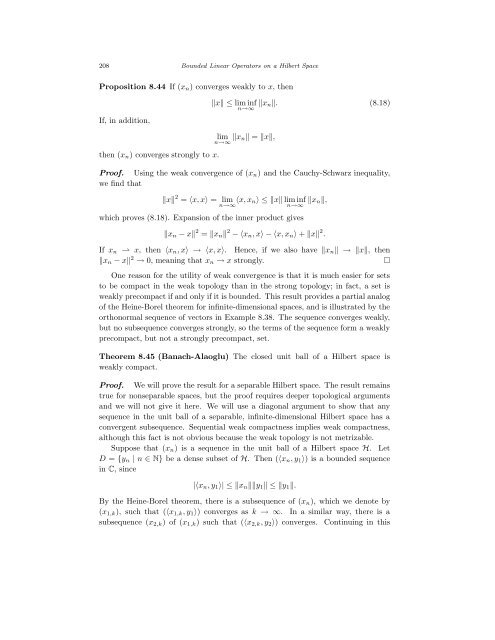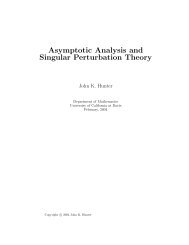Bounded Linear Operators on a Hilbert Space
Bounded Linear Operators on a Hilbert Space
Bounded Linear Operators on a Hilbert Space
You also want an ePaper? Increase the reach of your titles
YUMPU automatically turns print PDFs into web optimized ePapers that Google loves.
208 <str<strong>on</strong>g>Bounded</str<strong>on</strong>g> <str<strong>on</strong>g>Linear</str<strong>on</strong>g> <str<strong>on</strong>g>Operators</str<strong>on</strong>g> <strong>on</strong> a <strong>Hilbert</strong> <strong>Space</strong><br />
Propositi<strong>on</strong> 8.44 If (xn) c<strong>on</strong>verges weakly to x, then<br />
If, in additi<strong>on</strong>,<br />
then (xn) c<strong>on</strong>verges str<strong>on</strong>gly to x.<br />
x ≤ lim inf<br />
n→∞ xn. (8.18)<br />
lim<br />
n→∞ xn = x,<br />
Proof. Using the weak c<strong>on</strong>vergence of (xn) and the Cauchy-Schwarz inequality,<br />
we find that<br />
x 2 = 〈x, x〉 = lim<br />
n→∞ 〈x, xn〉 ≤ x lim inf<br />
n→∞ xn,<br />
which proves (8.18). Expansi<strong>on</strong> of the inner product gives<br />
xn − x 2 = xn 2 − 〈xn, x〉 − 〈x, xn〉 + x 2 .<br />
If xn ⇀ x, then 〈xn, x〉 → 〈x, x〉. Hence, if we also have xn → x, then<br />
xn − x 2 → 0, meaning that xn → x str<strong>on</strong>gly. <br />
One reas<strong>on</strong> for the utility of weak c<strong>on</strong>vergence is that it is much easier for sets<br />
to be compact in the weak topology than in the str<strong>on</strong>g topology; in fact, a set is<br />
weakly precompact if and <strong>on</strong>ly if it is bounded. This result provides a partial analog<br />
of the Heine-Borel theorem for infinite-dimensi<strong>on</strong>al spaces, and is illustrated by the<br />
orth<strong>on</strong>ormal sequence of vectors in Example 8.38. The sequence c<strong>on</strong>verges weakly,<br />
but no subsequence c<strong>on</strong>verges str<strong>on</strong>gly, so the terms of the sequence form a weakly<br />
precompact, but not a str<strong>on</strong>gly precompact, set.<br />
Theorem 8.45 (Banach-Alaoglu) The closed unit ball of a <strong>Hilbert</strong> space is<br />
weakly compact.<br />
Proof. We will prove the result for a separable <strong>Hilbert</strong> space. The result remains<br />
true for n<strong>on</strong>separable spaces, but the proof requires deeper topological arguments<br />
and we will not give it here. We will use a diag<strong>on</strong>al argument to show that any<br />
sequence in the unit ball of a separable, infinite-dimensi<strong>on</strong>al <strong>Hilbert</strong> space has a<br />
c<strong>on</strong>vergent subsequence. Sequential weak compactness implies weak compactness,<br />
although this fact is not obvious because the weak topology is not metrizable.<br />
Suppose that (xn) is a sequence in the unit ball of a <strong>Hilbert</strong> space H. Let<br />
D = {yn | n ∈ N} be a dense subset of H. Then (〈xn, y1〉) is a bounded sequence<br />
in C, since<br />
|〈xn, y1〉| ≤ xny1 ≤ y1.<br />
By the Heine-Borel theorem, there is a subsequence of (xn), which we denote by<br />
(x1,k), such that (〈x1,k, y1〉) c<strong>on</strong>verges as k → ∞. In a similar way, there is a<br />
subsequence (x2,k) of (x1,k) such that (〈x2,k, y2〉) c<strong>on</strong>verges. C<strong>on</strong>tinuing in this
















